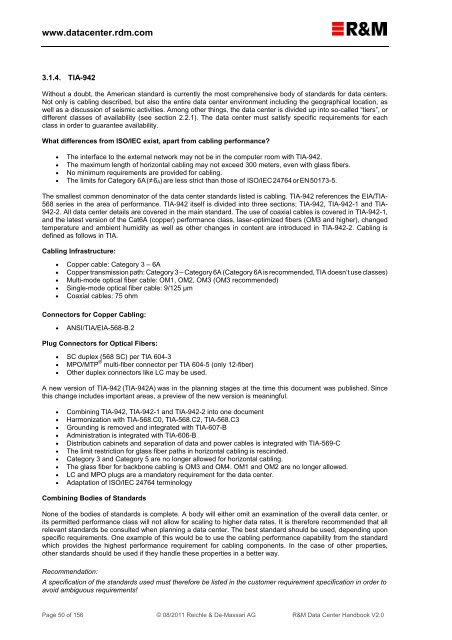R&M Data Center Handbook
R&M Data Center Handbook
R&M Data Center Handbook
Create successful ePaper yourself
Turn your PDF publications into a flip-book with our unique Google optimized e-Paper software.
www.datacenter.rdm.com<br />
3.1.4. TIA-942<br />
Without a doubt, the American standard is currently the most comprehensive body of standards for data centers.<br />
Not only is cabling described, but also the entire data center environment including the geographical location, as<br />
well as a discussion of seismic activities. Among other things, the data center is divided up into so-called “tiers”, or<br />
different classes of availability (see section 2.2.1). The data center must satisfy specific requirements for each<br />
class in order to guarantee availability.<br />
What differences from ISO/IEC exist, apart from cabling performance<br />
• The interface to the external network may not be in the computer room with TIA-942.<br />
• The maximum length of horizontal cabling may not exceed 300 meters, even with glass fibers.<br />
• No minimum requirements are provided for cabling.<br />
• The limits for Category 6A (≠ 6 A) are less strict than those of ISO/IEC 24764 or EN 50173-5.<br />
The smallest common denominator of the data center standards listed is cabling. TIA-942 references the EIA/TIA-<br />
568 series in the area of performance. TIA-942 itself is divided into three sections; TIA-942, TIA-942-1 and TIA-<br />
942-2. All data center details are covered in the main standard. The use of coaxial cables is covered in TIA-942-1,<br />
and the latest version of the Cat6A (copper) performance class, laser-optimized fibers (OM3 and higher), changed<br />
temperature and ambient humidity as well as other changes in content are introduced in TIA-942-2. Cabling is<br />
defined as follows in TIA.<br />
Cabling Infrastructure:<br />
• Copper cable: Category 3 – 6A<br />
• Copper transmission path: Category 3 – Category 6A (Category 6A is recommended, TIA doesn’t use classes)<br />
• Multi-mode optical fiber cable: OM1, OM2, OM3 (OM3 recommended)<br />
• Single-mode optical fiber cable: 9/125 µm<br />
• Coaxial cables: 75 ohm<br />
Connectors for Copper Cabling:<br />
• ANSI/TIA/EIA-568-B.2<br />
Plug Connectors for Optical Fibers:<br />
• SC duplex (568 SC) per TIA 604-3<br />
• MPO/MTP ® multi-fiber connector per TIA 604-5 (only 12-fiber)<br />
• Other duplex connectors like LC may be used.<br />
A new version of TIA-942 (TIA-942A) was in the planning stages at the time this document was published. Since<br />
this change includes important areas, a preview of the new version is meaningful.<br />
• Combining TIA-942, TIA-942-1 and TIA-942-2 into one document<br />
• Harmonization with TIA-568.C0, TIA-568.C2, TIA-568.C3<br />
• Grounding is removed and integrated with TIA-607-B<br />
• Administration is integrated with TIA-606-B<br />
• Distribution cabinets and separation of data and power cables is integrated with TIA-569-C<br />
• The limit restriction for glass fiber paths in horizontal cabling is rescinded.<br />
• Category 3 and Category 5 are no longer allowed for horizontal cabling.<br />
• The glass fiber for backbone cabling is OM3 and OM4. OM1 and OM2 are no longer allowed.<br />
• LC and MPO plugs are a mandatory requirement for the data center.<br />
• Adaptation of ISO/IEC 24764 terminology<br />
Combining Bodies of Standards<br />
None of the bodies of standards is complete. A body will either omit an examination of the overall data center, or<br />
its permitted performance class will not allow for scaling to higher data rates. It is therefore recommended that all<br />
relevant standards be consulted when planning a data center. The best standard should be used, depending upon<br />
specific requirements. One example of this would be to use the cabling performance capability from the standard<br />
which provides the highest performance requirement for cabling components. In the case of other properties,<br />
other standards should be used if they handle these properties in a better way.<br />
Recommendation:<br />
A specification of the standards used must therefore be listed in the customer requirement specification in order to<br />
avoid ambiguous requirements!<br />
Page 50 of 156 © 08/2011 Reichle & De-Massari AG R&M <strong>Data</strong> <strong>Center</strong> <strong>Handbook</strong> V2.0


